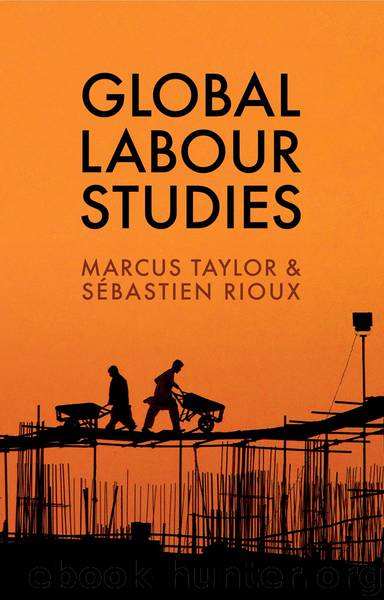Global Labour Studies by Marcus Taylor Sébastien Rioux & Sébastien Rioux

Author:Marcus Taylor,Sébastien Rioux & Sébastien Rioux
Language: eng
Format: epub
ISBN: 9781509504107
Publisher: John Wiley & Sons, Inc.
Published: 2017-12-19T00:00:00+00:00
Understanding Labour Migration
A migrant worker, in the words of the United Nations, can be defined as ‘a person who is to be engaged, is engaged or has been engaged in a remunerated activity in a state of which he or she is not a national’.1 While providing a useful entry point, this definition is limited because much labour migration is not international in character but occurs within the borders of a given state. According to the 2015 World Migration Report, there are some 740 million internal migrants in the world, outnumbering international migrants by around three to one.2 Many of these internal migrants are agricultural workers or smallholders who are pushed out of agriculture and move temporarily or permanently to cities (see chapter 7). For some, internal migration is circular – a temporary yet frequent move into other urban or rural regions to take advantage of seasonal work opportunities. For others, it can become permanent, particularly if existing rural livelihoods have become unviable or if the opportunities for employment and availability of other services in cities make return impractical.
The distinction between internal and international migration can also be blurred in cases where there are porous and shifting borders. This is especially prominent in former colonial areas where political borders do not fit people’s lived realities and sense of place and space. In southern Africa, for example, the movement of workers across permeable borders between Lesotho, Angola, Zimbabwe and Mozambique into South Africa is both longstanding and circular. Such workers form an important part of key labour market segments in South Africa, from mining to agricultural labour, and move seasonally between rural areas and cities on both sides of the border. This fluidity, however, can come with a price. Despite their porosity, crossing borders without official papers places migrants in a condition of vulnerability vis-à-vis both employers and officials. This typically relegates them to restricted labour market segments in which they have little power to shape their working conditions and are highly vulnerable to forms of exploitation including exposure to dirty, degrading or hazardous work.3
Given the intrinsic uncertainties involved in migration, any decision to migrate is never taken lightly. How, then, should we understand the forces driving migration that make it so central to the global economy? Geographer and cartographer Ernst Georg Ravenstein is usually considered the earliest migration theorist. Working from British censuses during the last quarter of the nineteenth century, Ravenstein identified a series of general propositions, or ‘laws of migration’, seeking to capture migration patterns. This approach was further developed in the 1960s by Everett Lee, whose so-called ‘push–pull’ model sought to understand migration decisions as a combination of four factors. First, one can identify a series of push factors in areas of origin such as war, political repression, unemployment, land shortage, gender oppression, famine and climate change. Second, pull factors in potential destinations may influence the decision to migrate; whether real or perceived, higher wages and standards of living, established networks of kin, perception of strong employment
Download
This site does not store any files on its server. We only index and link to content provided by other sites. Please contact the content providers to delete copyright contents if any and email us, we'll remove relevant links or contents immediately.
Bullshit Jobs by David Graeber(3826)
Radical Candor by Kim Scott(2579)
I Am Right, You Are Wrong by Edward De Bono(2338)
23:27 by H. L. Roberts(2140)
Nomadland by Jessica Bruder(1955)
Average Is Over by Tyler Cowen(1754)
The Conflict Resolution Phrase Book by Barbara Mitchell & Cornelia Gamlem(1646)
Out of Our Minds: Learning to Be Creative by Ken Robinson(1625)
High-Impact Interview Questions by Victoria A. Hoevemeyer(1611)
The Ideal Team Player by Patrick M. Lencioni(1562)
An Everyone Culture: Becoming a Deliberately Developmental Organization by Robert Kegan & Lisa Laskow Lahey(1527)
The Asshole Survival Guide by Robert I. Sutton(1504)
Automatic Society by Bernard Stiegler(1462)
Unleashed by Anne Morriss & Frances Frei(1421)
Who by Street Randy & Smart Geoff(1418)
Who Moved My Cheese?: An Amazing Way to Deal With Change in Your Work and in Your Life by Johnson Spencer(1417)
42 Rules of Employee Engagement by Susan Stamm(1396)
96 Great Interview Questions to Ask Before You Hire by Paul Falcone(1354)
The Power of Disability by Al Etmanski(1286)
